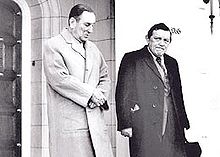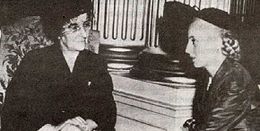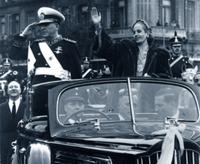| “ | When I realized that Perón, contrary to previous governments, gave Jewish citizens access to public office, I began to change my way of thinking about Argentine politics... Ezequiel Zabotinsky, president of the Jewish-Peronist Organizacion Israelita Argentina, 1952–1955[49] | ” |
Fraser and Navarro write that Juan Perón was a complicated man who over the years stood for many different, often contradictory, things.[50] In the book Inside Argentina from Perón to Menem author Laurence Levine, former president of the US-Argentine Chamber of Commerce, writes, "although anti-Semitism existed in Argentina, Perón's own views and his political associations were not anti-Semitic...." Laurence also writes that one of Perón's advisors was a Jewish man from Poland named José Ber Gelbard.[51] U.S. Ambassador George S. Messersmith visited Argentina in 1947 during the first term of Juan Perón. Messersmith noted, "There is not as much social discrimination against Jews here as there is right in New York or in most places at home..."[7]
Perón sought out other Jewish Argentines as government advisers, besides Ber Gelbard. The powerful Secretary of Media, Raúl Apold, also Jewish, was (ironically) called "Perón´s Goebbels." He favoured the creation of institutions like New Zion (Nueva Sión), the Argentine-Jewish Institute of Culture and Information, presided by Simón Mirelman, and the Argentine-Israeli Chamber of Commerce. Also, he named Rabbi Amran Blum the first Jewish professor of philosophy in the National University of Buenos Aires. After being the first Latin American government to acknowledge the State of Israel, he sent a Jewish ambassador, Pablo Mangel, to that country. Education and Diplomacy were the two strongholds of Catholic nationalism, and both appointments were highly symbolic. The same goes for the 1946 decision of allowing Jewish army privates to celebrate their holidays, which was aimed at fostering the Jewish position in another traditionally Catholic institution, the army.
Argentina signed a generous commercial agreement with Israel that granted favourable terms for Israeli acquisitions of Argentine commodities, and also the Eva Perón Foundation sent significant humanitarian aid. Chaim Weizmann and Golda Meir expressed their gratitude during their visit to Buenos Aires in 1951.
The German Argentine community in Argentina is the third largest ethnic group in the country, after the Spanish Argentines and the Italian Argentines. The German Argentine community predates Juan Perón's presidency, going back as far as the time of the unification of Germany. Laurence Levine writes that Perón found German civilization too "rigid" and therefore had a "distaste" for it.[51] Crassweller writes that while Juan Perón's own personal preference was for argentine culture, with which he felt a spiritual affinity, Perón was "pragmatic" in dealing with the diverse populace of Argentina.[7]
While Juan Perón's Argentina allowed many Nazi criminals to take refuge in Argentina, Juan Perón's Argentina also accepted more Jewish immigrants than any other country in Latin America, which in part accounts for the fact that Argentina to this day has a population of over 200,000 Jewish citizens, the largest in Latin America, the third largest in the Americas, and the sixth largest in the world.[52][53][54][55] TheJewish Virtual Library writes that while Juan Perón had sympathized with the Axis powers, "Perón also expressed sympathy for Jewish rights and established diplomatic relations with Israel in 1949. Since then, more than 45,000 Jews have immigrated to Israel from Argentina."[56]
Tomás Eloy Martínez, professor of Latin American studies at Rutgers University, writes that Juan Perón allowed Nazi criminals into the country in hopes of acquiring advanced German technology developed during the war. Martínez also notes that Eva Perón played no part in allowing Nazis into the country.[57]
[edit]Perón's second term
Facing only token UCR and Socialist Party opposition and despite being unable to field his popular wife, Eva, as a running mate, Perón wasre-elected in 1951 by a margin of over 30%.[58] This election was the first to have extended suffrage to Argentine women and the first in Argentina to be televised: Perón inaugurated Channel 7 public television that October. He began his second term in June 1952 with serious economic problems, however, compounded by a severe drought that helped lead to a US$500 million trade deficit (depleting reserves).[2]
Perón called employers and unions to a Productivity Congress to regulate social conflict through dialogue; but, the conference failed without reaching an agreement. Divisions among Peronists intensified, and the President's worsening mistrust led to the forced resignation of numerous valuable allies, notably Buenos Aires Province Governor Domingo Mercante.[1] Again on the defensive, Perón accelerated generals' promotions and extended them pay hikes and other benefits. He also accelerated landmark construction projects slated for the CGT or government agencies; among these was the 41-story and 141 m (463 ft) high Atlas Building (transferred to the Air Force by a later regime).[59]
Opposition to Perón grew bolder following the first lady's July 26, 1952, passing. On April 15, 1953, a terrorist group (never identified) detonated two bombs in a public rally at Plaza de Mayo, killing 7 and injuring 95. Amid the chaos, Perón exhorted the crowd to take reprisals; they made their way to their adversaries' gathering places, the Socialist Party headquarters and the aristocratic Jockey Club (both housed in magnificent turn-of-the-century Beaux-Arts buildings), and burned them to the ground.
A stalemate of sorts ensued between Perón and his opposition and, despite austerity measures taken late in 1952 to remedy the country's unsustainable trade deficit, the president remained generally popular. In March 1954, Perón called Vice-Presidential elections to replace the late Hortensio Quijano, which his candidate won by a nearly two-to-one margin. Given what he felt was as solid a mandate as ever and with inflation in single digits and the economy on a more secure footing, Perón ventured into a new policy: the creation of incentives designed to attract foreign investment.
Drawn to an economy with the highest standard of living in Latin America and a new steel mill in San Nicolás de los Arroyos, automakers FIAT and Kaiser Motors responded to the initiave by breaking ground on new facilities in the city of Córdoba, as did the freight truck division of Daimler-Benz, the first such investments since General Motors' Argentine assembly line opened in 1926. Perón also signed an important exploration contract with Standard Oil of California, in May 1955, consolidating his new policy of substituting the two largest sources of that era's chronic trade deficits (imported petroleum and motor vehicles) with local production brought in through foreign investment. The centrist Radical Civic Union's 1951 Vice-Presidential nominee, Arturo Frondizi, publicly condemned what he considered to be an anti-patriotic decision; as president three years later, however, he himself signed exploration contracts with foreign oil companies.
As 1954 drew to a close, Perón unveiled reforms far more controversial to the normally conservative Argentine public, the legalization of divorce and of prostitution. The Roman Catholic Church's Argentine leaders, whose support of Perón's government had been steadily waning since the advent of theEva Perón Foundation, were now open antagonists of the man they called "the tyrant." Though much of Argentina's media had, since 1950, been either controlled or monitored by the administration, lurid pieces on his ongoing relationship with an underage girl named Nélida "Nelly" Rivas,[60]something Perón never denied, filled the gossip pages.[3] Pressed by reporters on whether his supposed new paramour was, as the magazines claimed, thirteen years of age, the witty, fifty-nine year-old Perón responded that he was "not superstitious."[61]
Before long, however, the president's humor on the subject ran out and, following the expulsion of two Catholic priests he believed to be behind his recent image problems, Perón was excommunicated by Pope Pius XII on June 15, 1955. The following day, Péron called for a rally of support on the Plaza de Mayo, a time-honored custom among Argentine presidents during a challenge. However, as he spoke before a crowd of thousands, Navy fighter jets flew overhead and dropped bombs into the crowded square below before seeking refuge in Uruguay.
The incident, part of a coup attempt against Perón, killed 364 people and was, from a historical perspective, the only air assault ever on Argentine soil, as well as a portent of the mayhem that Argentine society would suffer in the 1970s.[3] It, moreover, touched off a wave of reprisals on the part of Peronists. Reminiscent of the incidents in 1953, Peronist crowds ransacked eleven Buenos Aires churches, including the Metropolitan Cathedral. On September 16, 1955, a nationalist Catholic group from both the Army and Navy, led by GeneralEduardo Lonardi, General Pedro E. Aramburu, and Admiral Isaac Rojas, led a revolt from Córdoba. Taking power in a coup three days later, which they named Revolución Libertadora (the "Liberating Revolution"). Perón barely escaped with his life, leaving Nelly Rivas behind,[62] and fleeing on the gunboat ARP Paraguay provided by Paraguayan leader Alfredo Stroessner, up the Paraná River.
At that point Argentina was more politically polarized than it had been since 1880. The landowning elites and other conservatives pointed to an exchange rate that had rocketed from 4 to 30 pesos per dollar and consumer prices that had risen nearly fivefold.[2][22] Employers and moderates generally agreed, qualifying that with the fact the economy had grown by over 40% (the best showing since the 1920s).[63]The underprivileged and humanitarians looked back upon the era as one in which real wages grew by over a third and better working conditions arrived alongside benefits like pensions, health care, paid vacations and the construction of record numbers of needed schools, hospitals, works of infrastructure and housing.[4]
[edit]Exile (1955–1973)
The new military regime went to great lengths to destroy both the President's and Eva Perón's reputation, putting up public exhibits of what they maintained was the Peróns' scandalously sumptous taste for antiques, jewelry, roadsters, yachts and other luxuries. They also accused other Peronist leaders of corruption; but, ultimately, though many were prosecuted, no one was convicted. The junta's first leader, Eduardo Lonardi, appointed a Civilian Advisory Board. Its preference for a gradual approach to de-Perónization helped lead to Lonardi's ousting, however (though most of the board's recommendations stood the new president's scrutiny).
Lonardi's replacement, General Pedro Aramburu, decreed the mere mention of Juan or Eva Perón's name to be illegal. Throughout Argentina, Peronism and the very display of Peronist mementoes was banned. Partly in response to these and other excesses, Peronists and moderates in the army organized a counter-coup against Aramburu, in June 1956. Possessing an efficient intelligence network, however, Aramburu foiled the plan, having the plot's leader, GeneralJuan José Valle, and 26 others executed. Aramburu turned to similarly drastic means in trying to rid the country of the spectre of the Peróns, themselves. Eva Perón's cadaver was removed from its display at CGT headquarters and ordered hidden under another name in a modest grave inMilan, Italy. Perón himself, for the time residing in Caracas, Venezuela at the kindness of ill-fated President Marcos Pérez Jiménez, suffered a number of attempted kidnappings and assassinations ordered by Aramburu.[64]
Continuing to exert considerable direct influence over Argentine politics despite the ongoing ban of Peronism or the Justicialist Party as Argentina geared for the 1958 elections, Perón instructed his supporters to cast their ballots for the moderate Arturo Frondizi, a splinter candidate within the Peronists' largest opposition party, the Radical Civic Union (UCR). Frondizi went on to defeat the better-known (but, more anti-Peronist) UCR leader, Ricardo Balbín. Perón backed a "Popular Union" (UP) in 1962, and when its candidate for governor of Buenos Aires Province (Andrés Framini) was elected, Frondizi was forced to resign by the military. Unable to secure a new alliance, Perón advised his followers to cast blank ballots in the 1963 elections, demonstrating direct control over one fifth of the electorate.[8]
Perón's stay in Venezuela had been cut short by the 1958 ousting of General Pérez Jiménez. In Panama, he met the nightclub singer María Estela Martínez (known as "Isabel"). Eventually settling in Madrid, Spain under the protection of Francisco Franco, he married Isabel in 1961 and was admitted back into the Catholic Church in 1963. Following a failed December 1964 attempt to return to Buenos Aires, he sent his wife to Argentina in 1965, to meet political dissidents and advance Perón's policy of confrontation and electoral boycotts. She organized a meeting in the house of Bernardo Alberte, Perón's delegate and sponsor of various left-wing Peronist movements such as the CGT de los Argentinos(CGTA), an offshoot of the umbrella CGT union. During Isabel's visit, adviser Raúl Lastiri introduced her to his father-in-law, José López Rega. A policeman with an interest in the occult, he won Isabel's trust through their common dislike of Jorge Antonio, a prominent Argentine industrialist and the Peronist movement's main financial backer during their perilous 1960s.[65] Accompanying her to Spain, López Rega worked for Perón's security before becoming the couple's personal secretary. A return of the Popular Union (UP) in 1965 and their victories in congressional elections that year helped lead to the overthrow of the moderate President Arturo Illia, and to the return of dictatorship.[8]
Perón became increasingly unable to control the CGT, itself. Though he had the support of its Secretary General, José Alonso, others in the union favored distancing the CGT from the exiled leader. Chief among them was Steel and Metalworkers Union head Augusto Vandor. Vandor challenged Perón from 1965 to 1968 by defying Perón's call for an electoral boycott (leading the UP to victories in the 165 elections), and with mottos such as "Peronism without Perón" and "to save Perón, one has to be against Perón." Dictator Juan Carlos Onganía's continued repression of labor demands, however, helped lead to Vandor's rapproachment with Perón—a development cut short by Vandor's as-yet unsolved 1969 murder. Labor agitation increased; the CGTA, in particular, organized opposition to the dictatorship between 1968 and 1972, and it would have an important role in the May–June 1969Cordobazo insurrection.[7]
Perón began courting the far left during Onganía's dictatorship. In his book La Hora de los Pueblos (1968), Perón enunciated the main principles of his purported new Tricontinental political vision:
| “ | Mao is at the head of Asia, Nasser of Africa, De Gaulle of the old Europe and Castro of Latin America.[66] | ” |
He supported the more militant unions and maintained close links with the Montoneros, a far-left Catholic Peronist group. On June 1, 1970, the Montoneros kidnapped and assassinated former anti-Peronist President Pedro Aramburu in retaliation for the June 1956 mass execution of a Peronist uprising against the junta. In 1971, he sent two letters to the film director Octavio Getino, one congratulating him for his work with Fernando Solanas and Gerardo Vallejo, in the Grupo Cine Liberación, and another concerning twofilm documentaries, La Revolución Justicialista and Actualización política y doctrinaria.[67]
He also cultivated ties with conservatives and the far right. He supported the leader of the conservative wing of the UCR, his erstwhile prisoner Ricardo Balbín, against competition from within the UCR itself. Members of the right-wing Tacuara Nationalist Movement, considered the first Argentine guerrilla group, also turned towards him. Founded in the early 1960s, the Tacuaras were a fascist, anti-Semitic and anti-conformist group founded on the model of Primo de Rivera's Falange, and at first strongly opposed Peronism. However, they split after the 1959 Cuban Revolution into three groups: the one most opposed to the Peronist alliance, led by Catholic priest Julio Meinvielle, retained the original hard-line stance; the New Argentina Movement (MNA), headed by Dardo Cabo, was founded on June 9, 1961, to commemorate General Valle's Peronist uprising on the same date in 1956, and became the precursor to all modern Catholic nationalist groups in Argentina; and the Revolutionary Nationalist Tacuara Movement (MNRT), formed by Joe Baxter and José Luis Nell, who joined Peronism believing in its capacity for revolution, and without forsaking nationalism, broke from the Church and abandoned anti-Semitism. Baxter's MNRT became progressively Marxist, and many of the Montoneros and of theERP's leaders came from this group.[7]
Following Onganía's replacement in June 1970, General Roberto M. Levingston proposed the replacement of Argentina's myriad political parties with "four or five" (vetted by the Revolución Argentina regime). This attempt to govern indefintely against the will of the different political parties united Peronists and their opposition in a joint declaration of November 11, 1970, billed as la Hora del Pueblo(The Hour of the People), which called for free and immediate democratic elections to put an end to the political crisis. The declaration was signed by the Radical Civic Union (UCRP), the Justicialist Party (Peronist Party), the Argentine Socialist Party (PSA), theDemocratic Progressive Party (PCP) and the Partido Bloquista (PB).[8]
The opposition's call for elections led to Levingston's replacement by General Alejandro Lanusse, in March 1971. Faced with strong opposition and social conflicts, General Lanusse declared his intention to restore constitutional democracy by 1973, though without Peronist participation. Lanusse proposed the Gran Acuerdo Nacional (Great National Agreement) in July 1971, which was to find an honorable exit for the military junta without allowing Peronism to participate in the election. The proposal was rejected by Perón, who formed the FRECILINA alliance (Frente Cívico de Liberación Nacional, Civic Front of National Liberation), headed by his new delegate Héctor José Cámpora (a member of the Peronist Left). The alliance gathered his Justicialist Party and the Integration and Development Movement (MID), headed by Arturo Frondizi. FRECILINA pressed for free and unrestricted elections, which ultimately took place in March 1973.











